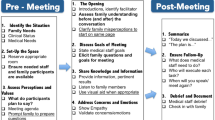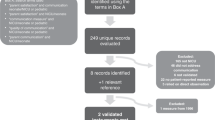Abstract
Objective:
To analyze the communicative contributions of interdisciplinary professionals and family members in enacted difficult conversations in neonatal intensive care.
Study Design:
Physicians, nurses, social workers, and chaplains (n=50) who attended the Program to Enhance Relational and Communication Skills, participated in a scenario of a preterm infant with severe complications enacted by actors portraying family members. Twenty-four family meetings were videotaped and analyzed with the Roter Interaction Analysis System (RIAS).
Result:
Practitioners talked more than actor-family members (70 vs 30%). Physicians provided more biomedical information than psychosocial professionals (P<0.001), and less psychosocial information than nurses, and social workers and chaplains (P<0.05; P<0.001). Social workers and chaplains asked more psychosocial questions than physicians and nurses (MD=P<0.005; RN=P<0.05), focused more on family's opinion and understanding (MD=P<0.01; RN=P<0.001), and more frequently expressed agreement and approval than physicians (P<0.05). No differences were found across disciplines in providing emotional support.
Conclusion:
Findings suggest the importance of an interdisciplinary approach and highlight areas for improvement such as using silence, asking psychosocial questions and eliciting family perspectives that are associated with family satisfaction.
This is a preview of subscription content, access via your institution
Access options
Subscribe to this journal
Receive 12 print issues and online access
$259.00 per year
only $21.58 per issue
Buy this article
- Purchase on Springer Link
- Instant access to full article PDF
Prices may be subject to local taxes which are calculated during checkout
Similar content being viewed by others
References
Meyer EC, Bigsby R . Family-centered and relationship-based care in the NICU In: Paul H. Brookes, Developmental and therapeutic interventions in the NICU. Brookes Publishing: Baltimore, 2004, pp 163–176.
Jellinek MS, Catlin EA, Todres DI, Cassem EH . Facing tragic decisions with parents in the neonatal intensive care unit: Clinical perspectives. Pediatrics 1992; 89: 119–122.
Javier A . How much emotion is enough. J Clin Ethics 2007; 18: 362–365.
Browning DM, Meyer EC, Brodsky D, Truog RD . Reflection on love, fear and specializing in the impossible. J Clin Ethics 2007; 18: 373–376.
Roter DL . Roter Interaction analysis system: Coding manual and training materials. Johns Hopkins University: Baltimore, 1989.
Ziv A, Wolpe PR, Small SD, Glick S . Simulation-based medical education: an ethical imperative. Acad Med 2003; 78: 783–788.
Dieckmann P, Gaba D, Rall M . Deepening the theoretical foundations of patient simulation as social practice. Simul Healthc 2007; 2: 183–193.
Browning DM, Meyer EC, Truog RD, Solomon MZ . Difficult Conversations in Health Care: Cultivating Relational Learning to Address the Hidden Curriculum. Acad Med 2007; 82: 905–913.
Meyer EC, Sellers DE, Browning DM, McGuffie K, Solomon MZ, Truog RD . Difficult conversations: Improving communication skills and relational abilities in healthcare. Pediatric Critical Care Medicine, in press.
Mckoul G . Communication skills: How simulation training supplements experiential and humanist learning. Acad Med 2006; 81: 271–274.
Inui TS, Carter WB, Kukull WA, Haigh VH . Outcome-based doctor-patient interaction analysis: I. Comparison of techniques. Med Care 1982; 10: 535–549.
Bensing JM, Dronkers J . Instrumental and affective aspects of physician behavior. Med Care 1992; 30: 283–298.
Roter D, Hall J, Katz N . Relations between physicians’ behaviors and patients’ satisfaction, recall, and impressions: An analogue study. Med Care 1987; 25: 399–412.
Roter DL, Stewart M, Putnam S, Lipkin M, Stiles W, Inui T . Communication patterns of primary care physicians. JAMA 1997; 277: 350–356.
Bertakis KD, Roter D, Putnam SM . The relationship of physician medical interview style to patient satisfaction. J Fam Pract 1991; 32: 175–181.
Roter DL, Larson S, Fischer CS, Arnold RM, Tulsky JA . Experts practice what they preach: A descriptive study of best and normative practices in end of life discussions. Arch Intern Med 2000; 160: 3477–3485.
Mack JW, Hilden JM, Watterson J, Moore C, Turner B, Grier HE et al. Parent and physician perspectives on quality care at the end of life in children with cancer. J Clin Oncol 2005; 23: 9155–9161.
Abbott KH, Sago JG, Breen CM, Abernethy AP, Tulsky JA . Families looking back: one year after discussion of withdrawal or withholding of life-sustaining support. Crit Care Med 2001; 29: 197–201.
Contro N, Larson J, Scofield S, Sourkes B, Cohen H . Family perspectives on the quality of pediatric palliative care. Arch Pediatr Adolesc Med 2002; 156: 14–19.
Azoulay E, Pochard F, Barnes NK, Chevret S, Aboab J, Adrie C et al. Risk of post-traumatic stress symptoms in family members of intensive care unit patients. Am J Respir Crit Care Med 2005; 171: 987–994.
McDonagh JR, Elliott TR, Engelberg RA, Treece PD, Shannon SE, Rubenfeld GD et al. Family satisfaction with family conferences about end-of-life care in the intensive care unit: increased proportion of family speech is associated with increased satisfaction. Crit Care Med 2004; 32: 1484–1488.
Meyer EC, Ritholz MD, Burns JP, Truog RD . Improving the quality of end-of-life care in the pediatric intensive care unit: parents’ priorities and recommendations. Pediatrics 2006; 117: 649–657.
Kowalski WJ, Leef KH, Mackley A, Spear ML, Paul DA . Communicating with parents of premature infants: who is the informant? J Perinatol 2006; 26: 44–48.
Azoulay E, Chevret S, Leleu G, Pochard F, Barboteu M, Adrie C et al. Half the families of intensive care unit patients experience inadequate communication with physicians. Crit Care Med 2000; 28: 3044–3049.
Harrison H . The principles for family-centerd neonatal care. Pediatrics 1993; 92: 643–650.
Levinson W, Chaumeton N . Communication between surgeons and patients in routine office visits. Surgery 1999; 125: 127–134.
Kindler CH, Szirt L, Sommer D, Häusler R, Langewitz W . A quantitative analysis of anesthetist-patient communication during the pre-operative visit. Anaesthesia 2005; 60: 53–59.
Meyer EC, Burns JP, Griffith JL, Truog RD . Parental perspectives on end-of-life care in the pediatric intensive care unit. Crit Care Med 2002; 30: 226–231.
Jones L, Woodhouse D, Rowe J . Effective nurse parent communication: A study of parents’ perceptions in the NICU environment. Patient Educ Couns 2007; 69: 206–212.
Wolfe J, Klar N, Grier HE, Duncan J, Salem-Schatz S, Emanuel EJ et al. Understanding of prognosis among parents of children who die of cancer. JAMA 2000; 284: 2469–2475.
Curtis JR, White DB . Practical guidance for evidence-based ICU family conferences. Chest 2008; 134: 835–843.
Pringle M, Stewart-Evans C . Does awareness of being video recoded affect doctors’ consultation behavior? Br J Gen Pract 1990; 40: 455–458.
Coleman T, Manku-Scott T . Comparison of video-recorded consultations with those in which patients’ consent is withheld. Br J Gen Pract 1998; 48: 971–974.
Dunn MS, Reilly MC, Johnston AM, Hoopes RD, Abraham MR . Development and dissemination of potentially better practices for the provision of family-centered care in neonatology: the family-centered care map. Pediatrics 2008; 118: S95–S107.
Cooper LG, Gooding JS, Gallagher J, Sternesky L, Ledsky R, Berns SD . Impact of a family-centered care initiative on NICU care, staff and families. J Perinatol 2007; 27: S32–S37.
Acknowledgements
We honor and dedicate this work to I David Todres, our friend and colleague, who passed away during the final revisions of this article. We acknowledge the Argosy Foundation for financial support of this work. We thank Anne Hansen, MD, Susan Larson, MS, Debra Roter, MPH. DrDh, Robert Truog, MD, and Allyson Wall, BA, for their many contributions. The authors express their gratitude to Pam Varrin, PhD, Erin Ward, MEd, Meg Comeau, MHA, who enriched the PERCS workshops offering parent perspectives, and to the actors and PERCS participants.
Author information
Authors and Affiliations
Corresponding author
Additional information
Supplementary Information accompanies the paper on the Journal of Perinatology website (http://www.nature.com/jp).
Supplementary information
Rights and permissions
About this article
Cite this article
Lamiani, G., Meyer, E., Browning, D. et al. Analysis of enacted difficult conversations in neonatal intensive care. J Perinatol 29, 310–316 (2009). https://doi.org/10.1038/jp.2008.228
Received:
Revised:
Accepted:
Published:
Issue Date:
DOI: https://doi.org/10.1038/jp.2008.228
Keywords
This article is cited by
-
Shared decision making, prospektive Lebensqualität und das beste Interesse des Kindes: ethische Herausforderungen im Kontext von Behandlungsentscheidungen bei Frühgeborenen an der Grenze der Lebensfähigkeit
Ethik in der Medizin (2023)
-
How to hold an effective NICU family meeting: capturing parent perspectives to build a more robust framework
Journal of Perinatology (2021)
-
Ethics and professionalism education during neonatal–perinatal fellowship training in the United States
Journal of Perinatology (2015)
-
An interdisciplinary, family-focused approach to relational learning in neonatal intensive care
Journal of Perinatology (2011)



